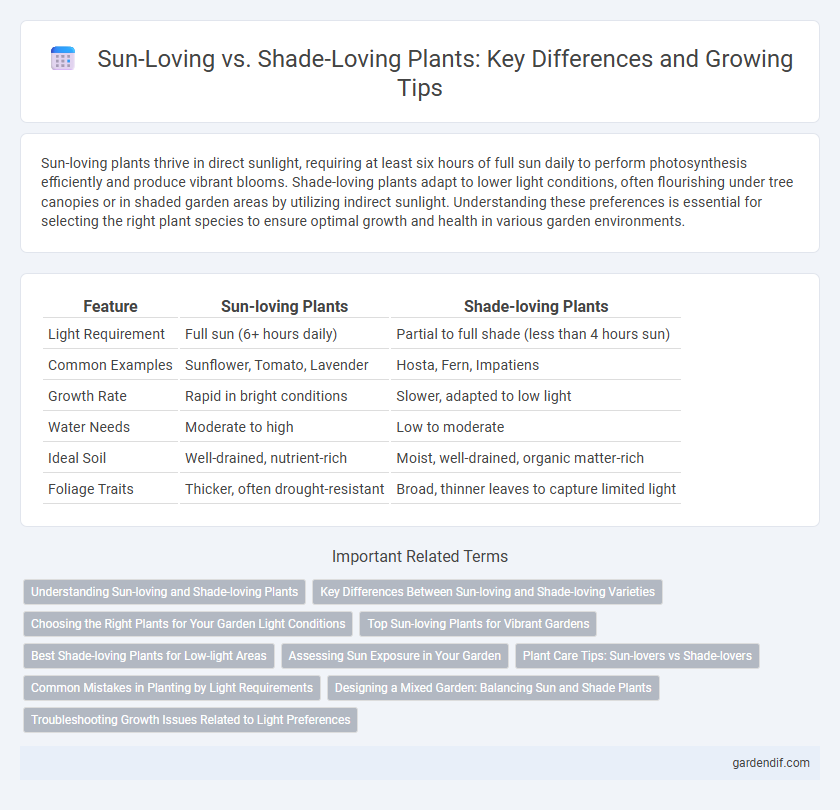
Sun-loving vs Shade-loving Illustration
Sun-loving plants thrive in direct sunlight, requiring at least six hours of full sun daily to perform photosynthesis efficiently and produce vibrant blooms. Shade-loving plants adapt to lower light conditions, often flourishing under tree canopies or in shaded garden areas by utilizing indirect sunlight. Understanding these preferences is essential for selecting the right plant species to ensure optimal growth and health in various garden environments.
Table of Comparison
| Feature | Sun-loving Plants | Shade-loving Plants |
|---|---|---|
| Light Requirement | Full sun (6+ hours daily) | Partial to full shade (less than 4 hours sun) |
| Common Examples | Sunflower, Tomato, Lavender | Hosta, Fern, Impatiens |
| Growth Rate | Rapid in bright conditions | Slower, adapted to low light |
| Water Needs | Moderate to high | Low to moderate |
| Ideal Soil | Well-drained, nutrient-rich | Moist, well-drained, organic matter-rich |
| Foliage Traits | Thicker, often drought-resistant | Broad, thinner leaves to capture limited light |
Understanding Sun-loving and Shade-loving Plants
Sun-loving plants thrive in environments with at least six hours of direct sunlight daily, optimizing photosynthesis for vigorous growth and flowering. Shade-loving plants adapt to lower light conditions by developing broader leaves and slower growth rates to maximize energy absorption. Understanding these light requirements is crucial for selecting appropriate plants that ensure healthy development and optimized landscape aesthetics.
Key Differences Between Sun-loving and Shade-loving Varieties
Sun-loving plants, such as tomatoes and lavender, require at least six hours of direct sunlight daily to thrive and perform photosynthesis efficiently, whereas shade-loving plants like ferns and hostas prefer filtered or indirect light and can suffer leaf scorch under intense sun exposure. Soil moisture needs differ, with sun-loving varieties typically needing well-drained soil and regular watering to prevent rapid drying, while shade-loving plants often thrive in consistently moist, nutrient-rich substrates with higher humidity. Growth patterns and flowering cycles also vary; sun-loving plants generally exhibit faster growth and more prolific blooms in full sun, whereas shade-loving varieties tend to grow slower with subtler flowering under low-light conditions.
Choosing the Right Plants for Your Garden Light Conditions
Sun-loving plants like tomatoes, lavender, and sunflowers thrive in full sunlight, requiring at least six hours of direct light daily to maximize photosynthesis and growth. Shade-loving plants such as ferns, hostas, and impatiens prefer indirect or filtered light, adapting to lower light intensities by optimizing chlorophyll efficiency and leaf structure. Selecting plants based on your garden's light exposure ensures optimal health, vibrant blooms, and sustained growth throughout the seasons.
Top Sun-loving Plants for Vibrant Gardens
Sun-loving plants such as lavender, marigolds, and zinnias thrive in full sunlight, offering vibrant colors and robust growth essential for bright garden spaces. These species require at least six hours of direct sunlight daily to maximize photosynthesis, resulting in stronger stems and prolific flowering. Choosing top sun-loving plants ensures a lively, colorful garden that flourishes in open, sunny environments.
Best Shade-loving Plants for Low-light Areas
Best shade-loving plants for low-light areas include species such as the Snake Plant (Sansevieria), ZZ Plant (Zamioculcas zamiifolia), and Cast Iron Plant (Aspidistra elatior), all known for their tolerance to minimal sunlight. Ferns like the Maidenhair Fern (Adiantum) and the Chinese Evergreen (Aglaonema) thrive in shaded environments, contributing to lush greenery without direct sun exposure. These plants excel in indoor or shaded garden spaces, improving air quality while requiring low maintenance in environments with limited light.
Assessing Sun Exposure in Your Garden
Assessing sun exposure in your garden involves measuring the intensity and duration of sunlight throughout the day, which determines whether plants thrive in full sun or prefer shade. Sun-loving plants require at least six hours of direct sunlight daily, while shade-loving varieties flourish in areas with less than three hours of direct sunlight or in filtered light. Using tools like a sunlight meter or observing shadow patterns helps gardeners strategically place plants for optimal growth and health.
Plant Care Tips: Sun-lovers vs Shade-lovers
Sun-loving plants such as tomatoes, lavender, and sunflowers require at least six hours of direct sunlight daily to thrive and produce vibrant blooms. Shade-loving plants like ferns, hostas, and impatiens prefer filtered sunlight or less than four hours of direct sun to avoid leaf scorch and maintain lush foliage. Proper watering schedules and soil conditions tailored to each plant type enhance growth, with sun-lovers needing well-drained soils and consistent moisture, while shade-lovers benefit from cooler, moist environments that prevent root rot.
Common Mistakes in Planting by Light Requirements
Planting sun-loving species in shaded areas often leads to stunted growth and poor flowering due to insufficient light for photosynthesis. Likewise, shade-loving plants exposed to prolonged direct sunlight may suffer leaf scorch and dehydration, severely impacting their health. Misjudging a plant's light requirement disrupts nutrient uptake and can result in increased susceptibility to pests and diseases.
Designing a Mixed Garden: Balancing Sun and Shade Plants
Designing a mixed garden requires strategic placement of sun-loving plants like lavender, marigolds, and tomatoes in areas receiving at least six hours of direct sunlight for optimal growth and vibrant blooms. Shade-loving plants such as hostas, ferns, and impatiens thrive in cooler, low-light environments under trees or shaded patios, helping maintain moisture and reduce soil temperature. Balancing sun and shade plants promotes biodiversity, improves garden aesthetics, and supports diverse pollinators by creating microclimates suited to each plant's light preferences.
Troubleshooting Growth Issues Related to Light Preferences
Sun-loving plants require at least six hours of direct sunlight daily to thrive, and insufficient light often results in leggy growth, reduced flowering, or leaf discoloration. Shade-loving plants prefer indirect or filtered light and may exhibit yellowing leaves or stunted growth when exposed to excessive sunlight. Adjusting plant placement based on specific light needs and monitoring symptoms like leaf burn or insufficient growth can help troubleshoot and optimize plant health effectively.
Sun-loving vs Shade-loving Infographic

 gardendif.com
gardendif.com